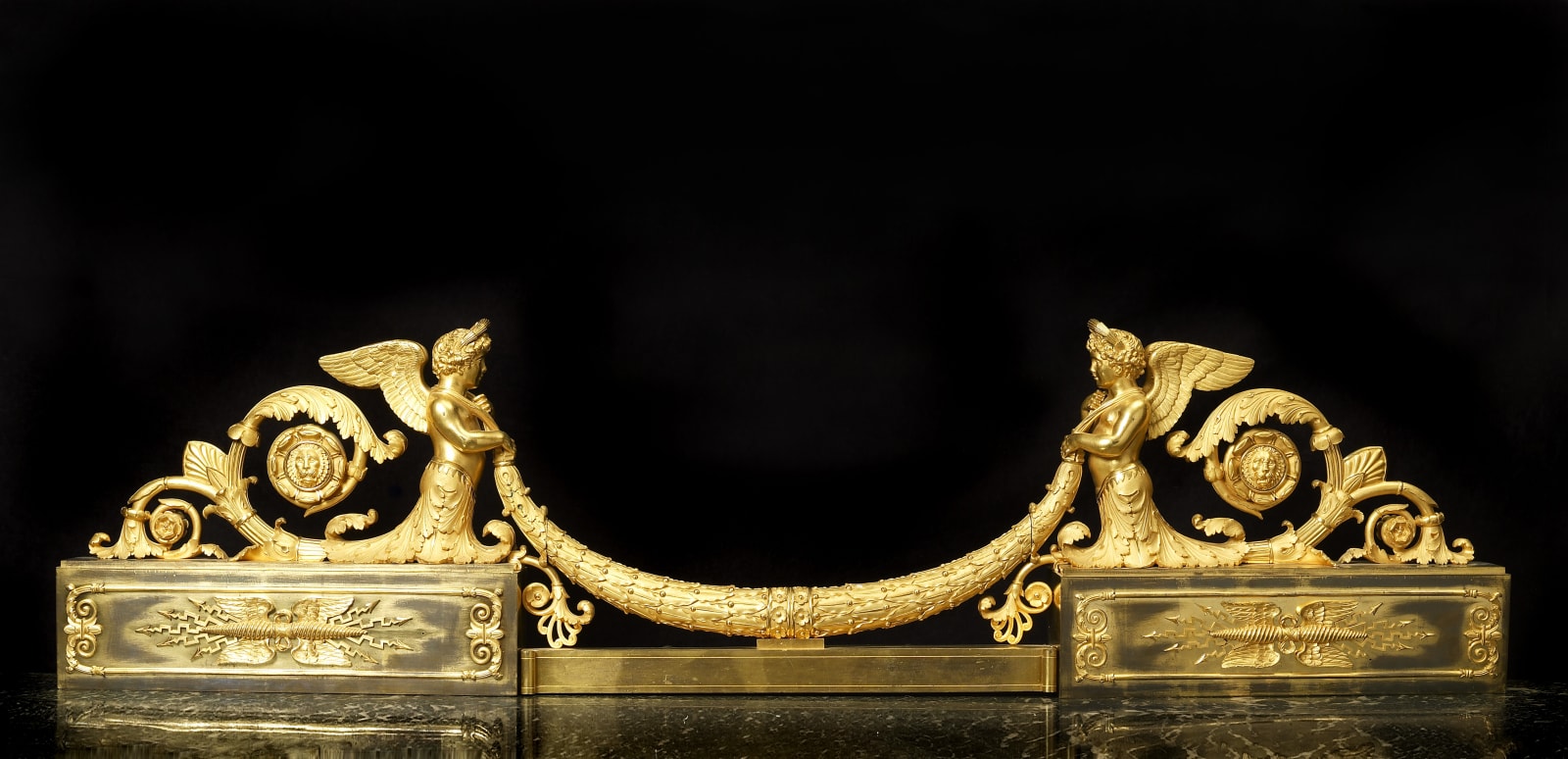Pierre-Philippe Thomire (attributed to) French, 1731-1843
Provenance
Louis Philippe d'Orléans.
Literature
Hans Ottomeyer and Peter Pröschel, "Vergoldete Bronzen", 1986, p. 341, pl. 5.4.6, illustrating a gilt and patinated bronze fender with sphinxes by Pierre-Philippe Thomire, circa 1805 with standards cast with almost identical motifs as here, which in addition are flanked by lion masks. And p. 340, pl. pl. 5.4.2, illustrating a watercolour design from an album (now in the Nationalmuseum in Stockholm), by Thomire's workshop for a fender surmounted by armorial motifs, commissioned by the King of Sweden, which shows at centre the same lion mask medallion as here, flanked by almost identical winged spiralled cones issuing thunder bolts.
A very fine Empire gilt bronze fender attributed to Pierre-Philippe Thomire and stamped with Louis Philippe d'Orléans's initials L.P.O. below a crown, the rectangular standards cast with winged spiralled cones issuing at each end forked thunder bolts and framed by a border with scrolled ends, each standard surmounted by a winged putti wearing a wreath headdress and emerging from acanthus and lotus scrolls terminated at centre by a lion mask medallion, each putti holding in its hands a scrolled berried laurel swagged rail
Paris, dated circa 1810-15
Length 138 cm, width 37 cm, depth 17 cm.
The quality and the close similarity with other fenders, cited above, leave little doubt as to an attribution of the present piece to the fondeur-ciseleur Pierre-Philippe Thomire (1751-1843). Undoubtedly the greatest craftsman of his age to work in bronze, Thomire first enjoyed the patronage of Louis XVI and then rose to even greater fame after the Revolution when his firm was appointed to Napoleon and also received commissions from the restored Bourbon and Orléans monarchy as well as foreign royalty and aristocracy. Born in Paris, he began his training under the sculptors Jean-Antoine Houdon and Augustin Pajou at the Académie St. Luc, Paris and then followed his father's profession as a fondeur-ciseleur. His career was advanced when he studied under the great fondeur-doreur, Pierre Gouthière from whom he acquired the most refined skills in chasing and gilding, in particular matt gilding 'dorure au matt', to produce a subtle grainy satin-like finish.
Appointed a maître-fondeur in 1772, he set up his own business in 1776 following his collaboration with Jean-Louis Prieur in the decoration of the coronation coach for Louis XVI.
In 1804 Thomire purchased an extensive business owned by Martin-Eloi Lignereux, the famous marchand-mercier. Renaming his company Thomire-Duterme et Cie, he was soon employing about 800 staff, both at his workshop at rue Boucherat and showroom at rue Taitbout. From there Thomire retailed a large range of decorative objects inspired by antiquity such as grand candelabra, centrepieces, urns, clock cases as well as fenders and fire surrounds.
The importance of the fender is enhanced by the fact that it was once owned by Louis Philippe, duc d'Orléans (1773-1850) who reigned as King of France, 1830-48. From his birth until 1785 he was known as the duc de Valois and subsequently as the duc de Chartres until 1793, when his father Louis Philippe Joseph, known as Philippe Égalité, was guillotined, and he succeeded him as duc d'Orléans. Like his father, he was in sympathy with the French Revolution and in 1790 joined the Jacobins but in 1793 was implicated in a plot against the republic. From then until the abdication of Napoleon, Louis Philippe lived outside France but on his return was welcomed by King Louis XVIII, who restored to him the Orléans estates. After the July Revolution of 1830 which saw the overthrow of Charles X, he was proclaimed king. Louis Philipp was known to be a great patron of the arts and connoisseur not only of the fine and decorative arts but also of the theatre, architecture and history.
